Browse Primary Sources
Locate primary sources, including images, objects, media, and texts. Annotations by scholars contextualize sources.
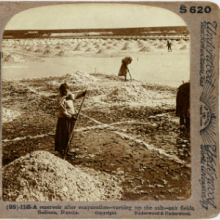
Salt Fields in Solinen, Russia
This stereograph, captioned "A reservoir after evaporation – turning up the salt – salt fields, Solinen, Russia," is an image of female workers breaking up the crust of salt formed after the evaporation of a reservoir and forming the salt into mounds for later collection. While the stereograph's caption notes the image was taken in Solinen, Russia, it most likely depicts the Kuyalnik estuary.
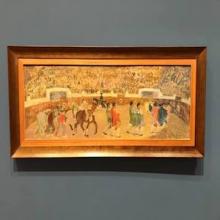
“Entrando a la plaza” by Pedro Figari
This painting from 1922 depicts a bullfight in a crowded arena of Montevideo, Uruguay. Scenes of these types of public events (also including circus and horse shows) were a favorite subject for the artist, Pedro Figari (1861-1938).

Artwork by Calixto Mamaní
Calixto Mamaní was an Argentine artist from the city of Salta, in the north of the country. His work emphasized the influence of the Incas, the indigenous peoples who ruled over much of the Andes Mountain region before the Spaniards arrived. These masks likely provide an example of this theme in his work.
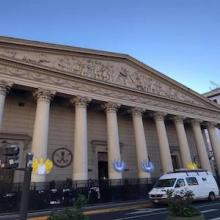
The Cathedral of Buenos Aires
The Catedral Metropolitana de Buenos Aires is the principal Catholic church in the capital city of Argentina. Although construction began around 1580, the church underwent a long building process, with expansions and repairs occurring over the next three-hundred years. It was built by the Spanish colonial government in the main town square, today called the Plaza de mayo.

Mexican Newspaper Reports on American Women Crossing the Border
This story appeared in the two-page daily English-language supplement to El Universal, Mexico City’s most authoritative newspaper at the time. The story told of Mexican officials refusing entry to a group of women from the United States who made repeated attempts to get into the country.

Espacio de Arte Contemporáneo
This building is located in the city of Montevideo, the capital of Uruguay. Once used for a prison, it now operates as a contemporary art museum. The complex was built in 1889 in the style of panopticon, which features several branches all centered around one point. That design intended to provide better security.

Portrait of Carlota Ferreira
This painting depicts a controversial figure in the history of Uruguay and Argentina. The subject is Carlota Ferreira, an upper-class woman born in Montevideo in 1838. She appears in fine clothing indicative of her social standing, such as her delicate white gloves and the gold jewelry that adorns her wrists. She was first married to Dr.
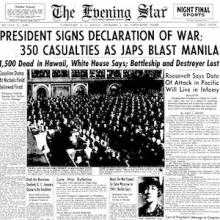
Newspaper Coverage of Pearl Harbor Bombing
When historians examine a particular story in a newspaper, they not only have to take into account the story's positioning on the page in relation to the other stories published that day, a way of getting a sense of the importance the editors assigned to the story, but also how a certain story has played out over several days in the same newspaper.

Hangzhou elites in 1935
The image shows an eclectic group of elites in Hangzhou in 1935, including Shanghainese gangster-businessmen Du Yuesheng and Zhang Xiaolin, Peking Opera star Mei Lanfang, Mayor of Hangzhou Zhou Xiangxian, and Japanese Consul at Hangzhou Yuzo Matsumura. Mei, Du, and Zhang were visiting Hangzhou to gather and donate funds for flood and poverty relief in the region.

Chinese Troops during the Xinhai Revolution
Image of Chinese troops dispatched by the Shanghai daotai of the collapsing Qing Dynasty to protect Xujiahui during the Xinhai Revolution.
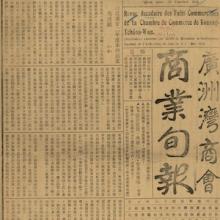
Chamber of Commerce Newspaper from Guangzhouwan, China
The image is of the front page of a newspaper (商業旬報 Shangye xunbao) published in 1934 by the Chamber of Commerce in Guangzhouwan (廣州灣商會 Guangzhouwan shanghui). Guangzhouwan was a territory on the Leizhou Peninsula in southern China that the French Republic leased from the Qing Dynasty at the end of the nineteenth century.

Letter to Council Women
In a 1960 letter, fourth national president of the National Council of Negro Women Dorothy Height reports back to the Council on her trip to Sierra Leone. She served as both participant and facilitator in what she described as the first meeting of West African women including Sierra Leone, Nigeria, Ghana, and Liberia.

“Tell Negroes To Join With Other Peoples Of The World”
An article in the Alabama Tribune reported on the visit of two West African women leaders, Mabel Dove from Ghana and Carmela Renner from Sierra Leone. The women leaders were hosted by the Norfolk chapter of the National Council of Negro Women.

Small Terracotta Male
This figure measures only 12.4 centimeters tall. It dates from some time between the seventeenth and eighteenth century. It depicts a clothed male figure, with buttons running down the font of his outfit. It also features a stand at the back to balance the figure.

Map of the Outskirts of Mexico City
This oil-on-canvas painting depicts part of Mexico City from above. Specific author or date information does not appear on the work, but it originates sometime in the seventeenth century. It is 119 centimeters wide. Analyzing its contents reveals some aspects of daily life during this period. It depicts an aqueduct on the right side of the piece.

Seventeenth Century Metal Helmet
This helmet dates to the seventeenth century, and has been restored. It belonged to the Governor and Captain of the Kingdom of New León, Martín de Zavala. This territory spanned the northwest region of modern-day Mexico. Throughout the colonial period, the men who Spain appointed to run its administration often had military backgrounds.

Portrait of Hernán Cortés
Hernán Cortés, a central figure in the establishment of Spanish rule in the Americas, is the subject of this painting. Throughout his career, he led several voyages back and forth between Spain, the Carribean, and Mexico.

Portrait of Gaspar Sánchez
This seventeenth century painting depicts the Jesuit theologian Gaspar Sánchez. He was born and educated in Spain, but his published works were distributed throughout the Spanish world. For example, the Jesuit library of Tepotzotlán has multiple volumes. Several aspects of this artwork shed light on the identity of Sánchez.

Portrait of Francisco López de Solís
This partially damaged painting depicts Francisco López de Solís, who occupied many posts throughout his career. He served as a lawyer for the Fisco del Santo Oficio, a judge on the high court of both the Philippines and Guatemala.

Female Terracotta Figure
This small piece measures only 9.8 centimeters tall. It depicts a clothed female figure, who appears to be wearing some kind of European-style belted dress with a collar. The Instituto Nacional de Antropología e Historia de México, which houses this piece, notes that these kinds of figures were used in Christmas decorations. It also has traces of stucco.